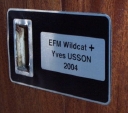EFM Wildcat rev 1 & rev 2
|
||
|
||
|
The EFM Wildcat is a single
board modular synthesizer
designed by Tom Gamble at EFM.
For
a very low cost it is possible to build a very efficient and powerful
modular
synthesizer. This page describes the progress of the assembly of my
Wildcat
system. Because I purchased a pre-release board (rev.1) a lot of PCB
design
errors had to be corrected. It took me some time but it was part of the
deal (reduced price for the rev-1 board) and also part of the fun. I
really
had a good time at tracking the bugs and troubleshooting these. In some
way, I brought a modest contribution to the release of the rev-2 board
that is now available. I also purchased a rev2 board in which most of
the bugs have been fixed.
I also made some improvements to the original design : purer
waveshapes,
hum noise rejection and so on... The current status is :
To conclude, I must say that
the now defunct EFM_SYNTH
list was very helpful! There's always somebody in the list to help
you sorting out electronic problems. Thanks very much to Harry Bissell,
Dave Magnuson, Rich Hess and Tom Gamble for their helpful advices.
|
||
|









